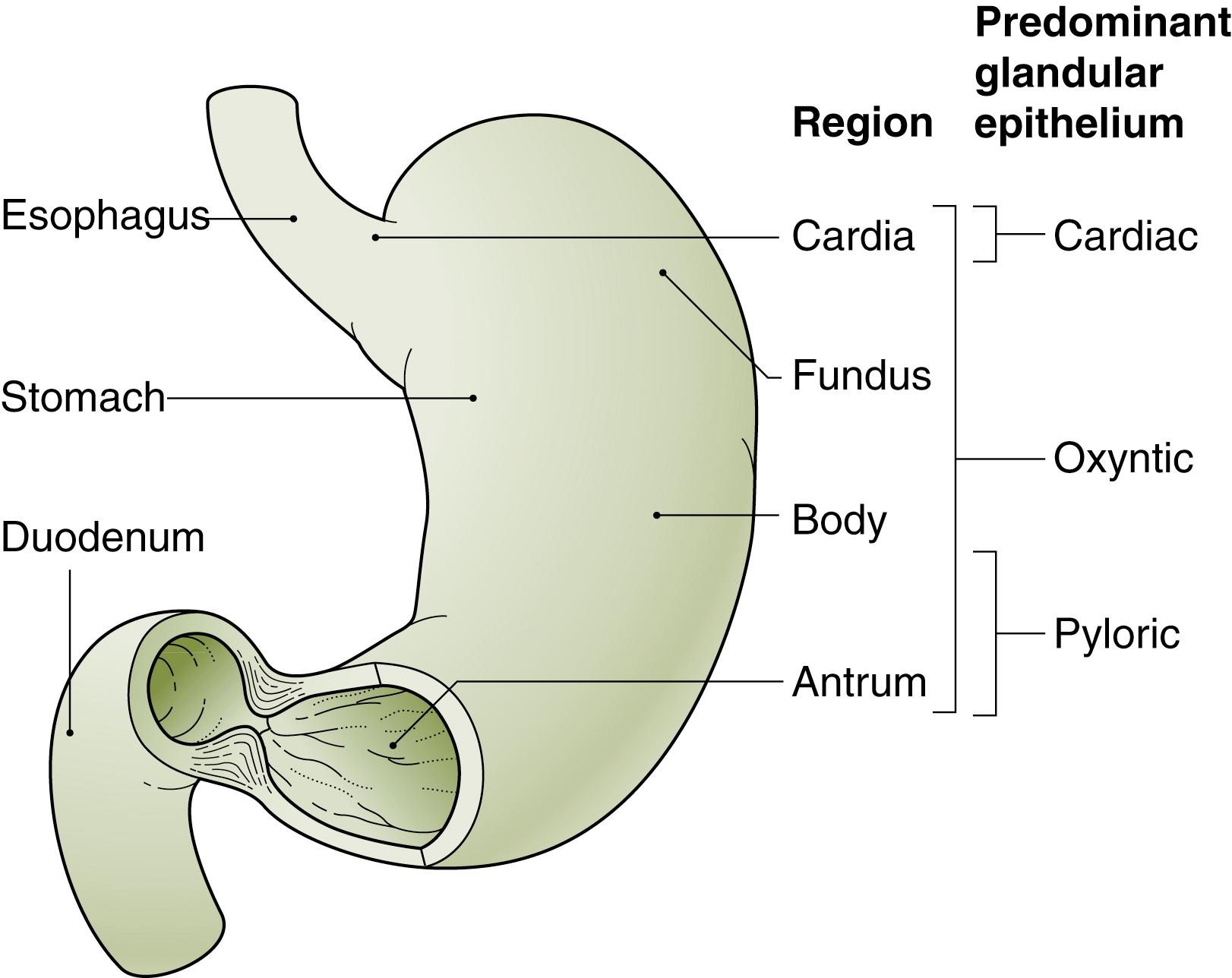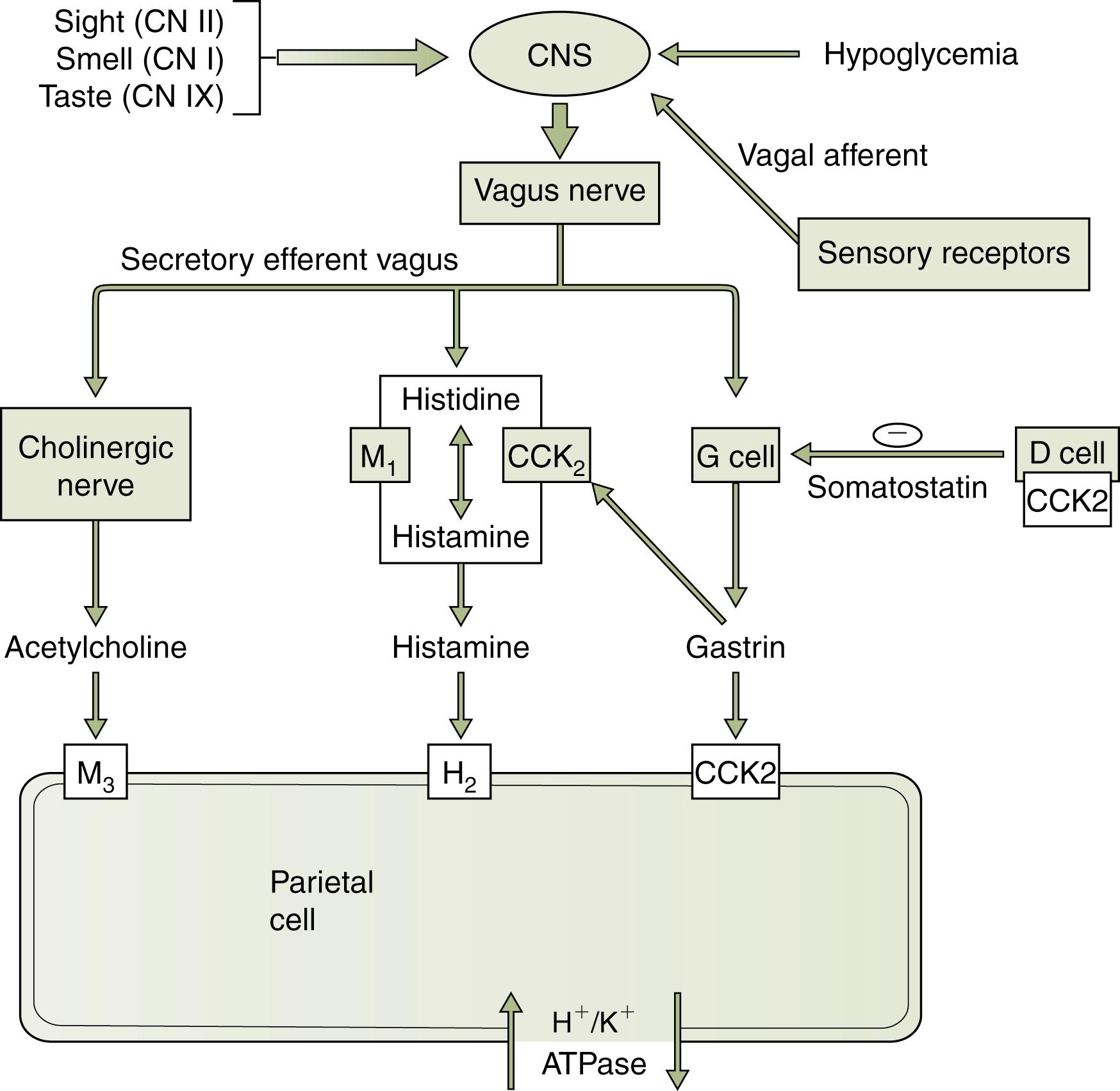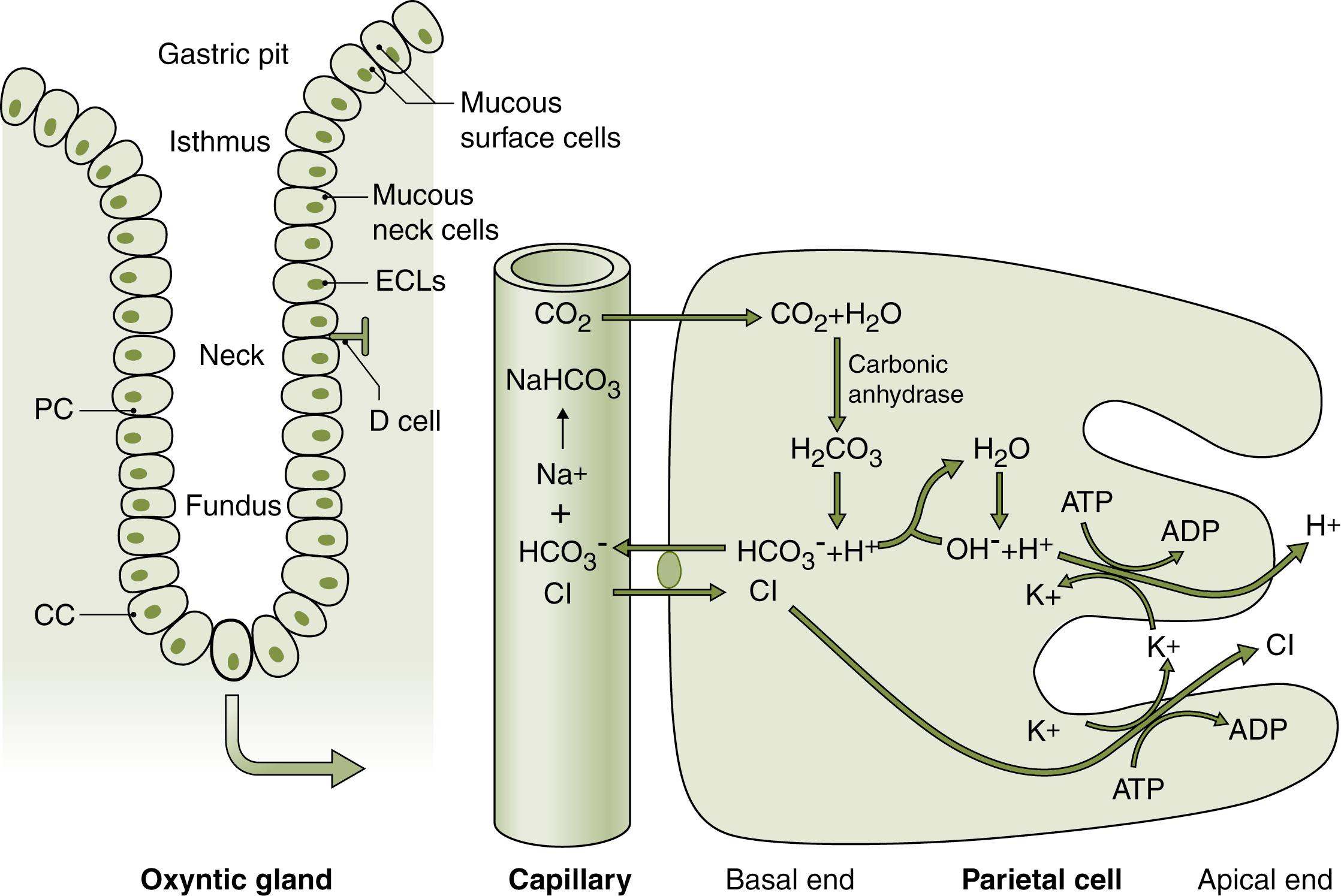Physical Address
304 North Cardinal St.
Dorchester Center, MA 02124
The gastrointestinal tract begins as a primitive tubular system and is one of the first organs to polarize the embryo by forming an entry and exit with an anterior and posterior axis, also known as the craniocaudal axis, extending from the mouth to the cloaca ( Fig. 24.1 ). The nonneural elements of the gut are derived from endodermal and mesodermal cells. Bilateral folding of these layers forms the intestinal lumen, which is surrounded by concentric endodermal and splanchnic epithelia, creating a tubular gut. Cells from the outer epithelium migrate outward and form a loose mesenchyme, which later forms the muscle and connective tissue, whereas neural elements migrate from the neural crest at the vagal and sacral levels to form the enteric nervous system.
The tubular gut has three distinct sections: the foregut, midgut, and hindgut. One of the first gross morphologic distinctions is the rotation and distension of the posterior foregut to begin differentiating the stomach just distal to the esophagus. The stomach is also separated from the esophagus by the newly formed diaphragm from the developing abdominal cavity. At the end of the fourth and beginning of the fifth week, the stomach can be recognized as a fusiform dilation, which is initially oriented in the median plane. This primordial stomach soon enlarges and broadens ventrodorsally. During the next 2 weeks, the dorsal border of the primordial stomach grows faster than its ventral border (lesser curvature), demarcating the greater curvature of the stomach. As the stomach enlarges, it rotates slowly 90 degrees in a clockwise direction around its longitudinal axis. The ventral border moves to the right, and the dorsal border (greater curvature) moves to the left, changing the position of the stomach. The original left side moves to the ventral surface, and the right side moves to the dorsal surface. During rotation and growth of the stomach, the cranial region moves to the left and slightly inferiorly, and its caudal region moves to the right and superiorly. After rotation, the stomach assumes its final position in the upper abdomen, with its long axis almost transverse to the long axis of the body. The rotation and growth of the stomach explain why the left vagus nerve supplies the anterior wall of the adult stomach and the right vagus nerve innervates the posterior wall of the stomach.
Arterial blood supply to the distal esophagus, stomach, and proximal duodenum is derived from the branches of celiac axis. The stomach is drained by the left gastric vein, right gastric vein, right and left gastroepiploic veins, and short gastric veins. These veins have no valves and can provide collateral blood flow when any portion of the portal system is obstructed. Esophageal and gastric varices usually involve the left gastric and short gastric veins.
The lymphatic drainage from the stomach enters the thoracic duct via the celiac nodes. Ultimately, the lymphatic drainage enters the venous system in the neck at the junction of the left internal jugular and left subclavian vein. Because of this anatomic relationship, gastric malignancies in adults may present with left supraclavicular lymph node metastasis.
Vagal and sympathetic fibers innervate the entire stomach by about 9 weeks of gestation. Two major networks of nerve fibers are intrinsic to the gastrointestinal tract: the myenteric plexus (Auerbach plexus), which can be found between the outer longitudinal and middle circular layers of muscle, and the submucous plexus (Meissner plexus), located between the middle circular muscular layer and the mucosa. Collectively, these neurons constitute the enteric nervous system. Catecholamines have been demonstrated in sympathetic fibers in the Auerbach plexus by week 10 and in the Meissner plexus by week 13.
Development of fetal human gastric mucosa occurs very early during fetal life. The first pit/gland structures are observed at 11 to 12 weeks of gestation. Between 11 and 17 weeks, the stratified surface epithelium is replaced by a simple mucous columnar epithelium, and gastric glands develop further. At this stage, the progenitor zone of the pit/gland structure is already localized in the isthmus, as in adult mucosa. ,
The gastric mucosa is organized in vertical tubular units consisting of an apical pit region, an isthmus, and the actual gland region that forms the lower part of the vertical unit. The progenitor cell of the gastric unit gives rise to all epithelial cells. The mucus-producing pit cells migrate up toward the gastric lumen, and acid-secreting parietal cells (oxyntic; oxys is Greek for acid) migrate downward to the middle and lower regions of the gland. Chief (zymogenic) cells secrete pepsinogen and predominate at the base of glands. Neuroendocrine cells, including enterochromaffin cells (serotonin), enterochromaffin-like cells (ECLs; histamine), and D cells (somatostatin) are also present at the base of the gland.
The glands of the different anatomic parts of the stomach are lined with different types of cells ( Fig. 24.2 ). The cardiac glands are mostly populated by mucus-secreting or endocrine cells. The cardiac pits are irregular and shallow; the ratio of the length of pit-to-glands is approximately 1:1. In the body of the stomach, including the fundus, the glands are long and deep with straight pits. The ratio of the length of pits-to-glands is approximately 1:4. The gastric gland has parietal (oxyntic) cells that secrete hydrochloric acid and intrinsic factor, chief (zymogen, peptic) cells that secrete pepsinogen, and endocrine and mucous neck cells. The antrum and pylorus contain the pyloric glands, composed of mainly mucus, endocrine, and G cells. There are very few parietal or chief cells. The glands here are characterized by deep pits but short glands, with a pit-to-gland ratio close to 1:1. Mucus is also secreted along with bicarbonate (HCO 3 − ) by the surface mucous cells between glands. Surface mucous cells secrete neutral mucus, rather than the sulfated mucus secreted by mucous neck cells, which reside in proximity to parietal cells. The surface mucous cells are cytoprotective, whereas the mucous neck cell functions as a stem cell precursor for surface mucus and parietal, chief, and endocrine cells.

Gastric motility is controlled centrally as well as by local neurohormonal control of the muscle layers, which include outer longitudinal, middle circular, and inner oblique fibers. Neuronal control involves the intrinsic myenteric plexus, the extrinsic postganglionic sympathetic fibers of the celiac plexus, and the preganglionic parasympathetic fibers of the vagus nerve. The vagal afferents are both relaxatory and excitatory.
Functionally, the stomach can be divided into two parts: the proximal stomach and the antrum. The proximal stomach, consisting of the cardia, fundus, and a portion of the body, is responsible for the storage of food and is capable of accommodating a large volume of nutrients with receptive relaxation and no dramatic rise in intragastric pressure. Di Lorenzo et al. demonstrated that the receptive relaxation of the proximal stomach is negligible in infants; this might explain in part the increased incidence of reflux in newborns.
The rate at which the stomach empties into the duodenum also depends on the type and components of food ingested. Liquids and solids have different mechanisms of emptying. An increased tonic intraluminal pressure in the fundus is necessary for the emptying of liquids. Liquid emptying has an exponential pattern of emptying that is dependent on the volume ingested, as well as the osmolarity of the liquid. This is determined largely by the pressure differences between the stomach and duodenum and is modulated by receptors in the duodenum that slow gastric emptying when the caloric density or volume load reaching the duodenum is excessive.
Solid food emptying has an initial lag phase followed by a linear phase. The distal stomach, which consists of the antrum and pylorus, is responsible for grinding and emptying solid food. Gastric peristaltic waves originating in the body of the stomach propagate toward the pylorus. The antral contractions allow only the small particles and liquids to pass into the duodenum and drive the larger particles (>0.2 mm) back into the body of the stomach by retrograde propulsion. Food rich in carbohydrate leaves the stomach within a few hours. However, protein-rich food leaves more slowly, and emptying is slowest after a meal containing a significant amount of fat. Finally, the rate of emptying also depends on antral distension (gastrogastric reflex); concentration of lipid, protein, and acid in the duodenum (duodenogastric reflex); and colonic distension (cologastric reflex). ,
Because of ingesting a meal, gastric distension stimulates “gastric mechanoreceptors”; hyperosmolality of the duodenal contents sensed by “duodenal osmoreceptors” initiates both enterogastric neural reflexes. Cholecystokinin (CCK) is released in response to this reflux and binds to CCK1 receptors (CCK1Rs) on gastric afferents, producing inhibition of the excitatory vagal efferents to the fundus. The primary inhibitory neurotransmitter is nitric oxide, which controls transpyloric flow, antral motility, and pyloric contraction. Serotonin is also involved in the inhibitory pathway. Appropriate propagation of gastric contractions or antroduodenal coordination is of great importance to the emptying of the stomach. Gastric motility is regulated by gastric myoelectric activity and consists of gastric slow waves and spike or second potentials. The gastric slow wave determines the propagation and maximum frequency of gastric contractions. It is generated in an area of the greater curvature that has the fastest rate of inherent rhythmicity and acts as a pacemaker controlling the rate and direction of propagation of gastric electrical activity. The normal frequency of gastric slow waves is 3 cycles per minute (cpm) in healthy humans. Abnormalities in the frequency of the gastric slow waves have been reported in a number of clinical settings, associated with gastric motor disorders and gastrointestinal symptoms. Gastric slow-wave activity can be measured noninvasively using the technique of electrogastrography (EGG). Gastric motor activity initially appears between the gestational ages of 14 and 24 weeks. EGG patterns at 35 weeks of gestation are similar to that of a full-term infant. EGG patterns continue to mature over the first 6 to 24 months, reaching a stable pattern.
A characteristic feature of fasting motor activity in the older child is the migrating motor complex (MMC), a highly organized propagated sequence of contractions that migrates from the stomach into the intestine and toward the ileum every 90 to 120 minutes. Three distinctive phases appear in sequence. Phase 1 is a pattern of quiescence that always follows phase 3. Phase 2 is a period of irregular contractions, varying in amplitude and periodicity. Because of this variation, some contractions are not propagated. Phase 3 is a distinctive pattern of regular high-amplitude contractions repeating at a maximal rate for 3 to 10 minutes and migrating from proximal to distal. The MMC begins anywhere from the esophagus to the ileum. About half of these contractions begin in the esophagus or the gastric body and migrate downward. Motilin is responsible for initiating phase 3 contractions that begin in the stomach. Gastric MMCs are present in newborns and preterm infants older than 32 weeks of gestation. In younger preterm infants, only uncoordinated, nonmigrating contractions are present. The clinical implications of nonmigrating phase 3 contractions in very preterm infants are unknown. Theoretically, nonmigrating phase 3 contractions should not cause feeding intolerance, because liquid gastric emptying is related to the function of fundus and not to antral peristalsis.
The stomach secretes water, electrolytes, hydrochloric acid, and glycoproteins, including mucin, intrinsic factor, and enzymes ( Fig. 24.3 ).

Gastric motility and secretion are regulated by neural and humoral mechanisms. For convenience, the physiologic regulation of gastric secretion is usually discussed as being either cephalic or peripheral , which includes both gastric and intestinal influences, although these overlap. The cephalic influences are vagally mediated responses induced by activity in the central nervous system. The vagus nerve contains afferent fibers that transmit sensory information from the gut to the brainstem and efferent fibers that form the motor limb of the vagovagal reflexes. The cephalic phase of acid secretion is induced by sensory inputs of the thought, smell, sight, and taste of the food. The efferent fibers for this reflex are in the vagus nerves. Cephalic influences are responsible for one-third to one half of the acid secreted in response to a normal meal and are abolished by vagotomy. Vagal stimulation increases gastrin secretion by release of gastrin-releasing peptide (GRP), or bombesin. Other vagal fibers release acetylcholine, which acts directly on the cells in the glands in the body and the fundus of the stomach. Acetylcholine binds to M 3 muscarinic receptors on the parietal cell and stimulates gastric acid secretion via calcium and phosphoinositol pathways.
The peripheral mechanisms include gastric influences, consisting of local reflex responses to gastrin, and intestinal influences, reflex, and hormonal feedback effects on gastric secretion initiated from the mucosa of the small intestine. Finally, the stomach also contains exocrine epithelial cells and endocrine-like neural regulatory cells.
Golgi first proposed that the parietal cell was the source of gastric acid and that it was formed within the surface invaginations, which he termed secretory canaliculi . The ultrastructure of the parietal cell has numerous large mitochondria to provide adenosine triphosphate (ATP) for acid secretion. The H + ,K + -ATPase (gastric acid pump, or proton pump) is a membrane-embedded protein identified and isolated in the 1970s. Parietal cells express receptors for acetylcholine, gastrin, and histamine ( Fig. 24.4 ). The binding of these ligands to receptors on the surface of the parietal cell starts changes in second messengers that regulate the movement and location of the gastric proton pump. The H + ,K + -ATPase exchanges protons for potassium and is responsible for gastric luminal acidification. In the resting state, the enzyme is stored in the cytoplasmic tubulovesicles. When the parietal cells are stimulated, the tubulovesicular structures fuse with the apical membrane to form secretory canaliculus and the proton pumps start actively pumping H + ions in exchange for K + . The proteins involved in the translocation and fusion of H,K-ATPase include ezrin, actin, myosin, Rab GTPase, and soluble N-ethylmaleimide-sensitive factor attachment protein receptors (SNAREs). Ezrin, an actin-binding protein localized to the apical canalicular membrane of parietal cells, is crucial for tubulovesicle docking and fusion. Ezrin and MST4 work collaboratively to promote histamine-stimulated acid secretion.

Pumping H + out of the parietal cells in exchange for K + requires appreciable energy, and this is provided by hydrolysis of ATP. Cl − is also extruded down its electrochemical gradient through channels that are activated by cyclic adenosine monophosphate (cAMP) in the apical membrane. Ultimately, acid is generated from the dissociation of two molecules of water to form H 3 O + and OH − . The H 3 O + is secreted via the proton pump in exchange for K + , whereas the corresponding OH − combines in the cell with carbon dioxide to form HCO 3 − . This reaction is catalyzed by carbonic anhydrase, and the parietal cells are particularly rich in this enzyme. The formed HCO 3 − is extruded by a conductance pathway on the basolateral membrane in exchange for Cl − ions.
The H + ,K + -ATPase is a heterodimer composed of two noncovalently linked subunits, α and β. The α subunit contains the catalytic site of the enzyme, which is important for functioning of the H + ,K + -ATPase. It contains the cysteine residues where proton pump inhibitors bind. The β subunit appears to play a role in formation of tubulovesicle membranes and the transfer of enzyme to the apical membrane and may protect the enzyme from degradation.
Gastrin, produced by the antral G cell, is the most potent endogenous stimulant of gastric acid secretion during ingestion of a meal. The major stimulant of G cells in pyloric and duodenal glands is luminal amino acids derived from peptic hydrolysis of dietary proteins. Gastrin stimulates the parietal cells directly, acting via CCK2Rs (previously termed CCK b ) receptors, and indirectly by stimulating ECLs to secrete histamine. Histamine induces acid secretion by activating parietal cell H 2 receptors. The action of gastrin is mediated by an increase in intracellular calcium concentration compared with that of histamine, which is mediated by an increase in both calcium and cAMP levels.
In addition to stimulating gastric acid secretion, gastrin has trophic effects on gastric oxyntic mucosa. Gastrin stimulates the migration of gastric epithelial cells directly and indirectly via multiple pathways that include the release of fibroblast growth factor, activation of the epidermal growth factor receptor, and activation of the mitogen-activated protein kinase pathway.
Gastrin is also found in the pancreatic islets in fetal life. This may explain why gastrin-secreting tumors, called gastrinomas, occur in the pancreas. It is uncertain whether any gastrin is present in the pancreas of normal adults. Zollinger-Ellison syndrome (ZES), caused by a gastrin producing tumor, presents with peptic ulcer disease and diarrhea as a result of gastric acid hypersecretion. Twenty percent of patients with ZES develop multiple endocrine neoplasia type 1 (MEN1). Although the syndrome was originally described for tumors in the pancreas, currently, gastrinomas are more commonly seen in the duodenum.
Histamine is stored primarily in the ECLs that reside in the basal half of the oxyntic gland (corpus and fundus). It is formed by the decarboxylation of histidine by histidine decarboxylase. Histamine receptors have been classified into four major subclasses: H 1 , H 2 , H 3 , and most recently, H 4 . Histamine, released from ECLs, stimulates acid secretion primarily by interacting with H 2 receptors on parietal cells. H 3 receptor agonists have been reported to stimulate acid secretion in vitro and to inhibit acid secretion in vivo. The former is caused by inhibition of gastric somatostatin secretion, whereas the latter is more than likely caused by the central effects of these agents. , Gastrin, aspirin, indomethacin, dexamethasone, interleukin 1, and tumor necrosis factor stimulate histidine decarboxylase activity. Antisecretory agents also stimulate histidine decarboxylase as a result of hypochlorhydria-induced gastrin secretion. Apart from histamine, ECLs contain chromogranin A (CgA), pancreastatin, and parathyroid hormone-like hormone (PTHLH).
Become a Clinical Tree membership for Full access and enjoy Unlimited articles
If you are a member. Log in here